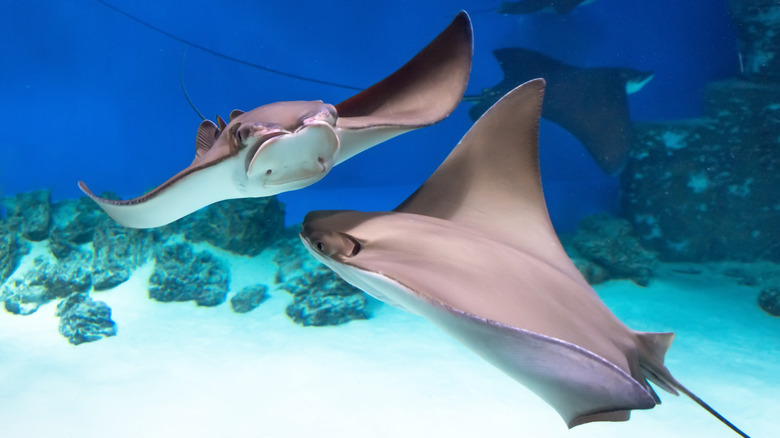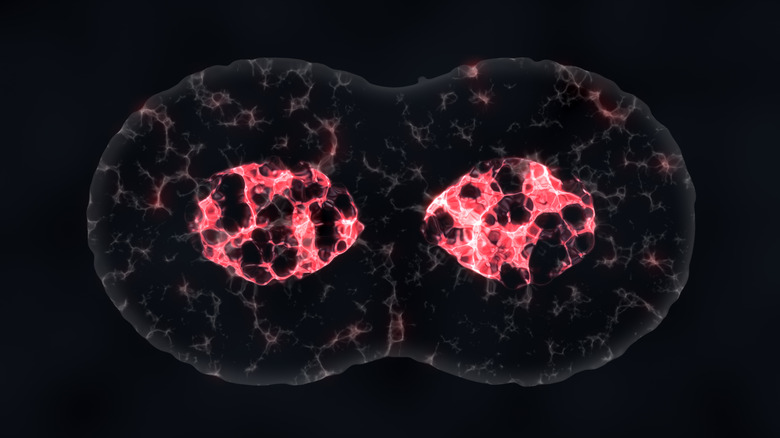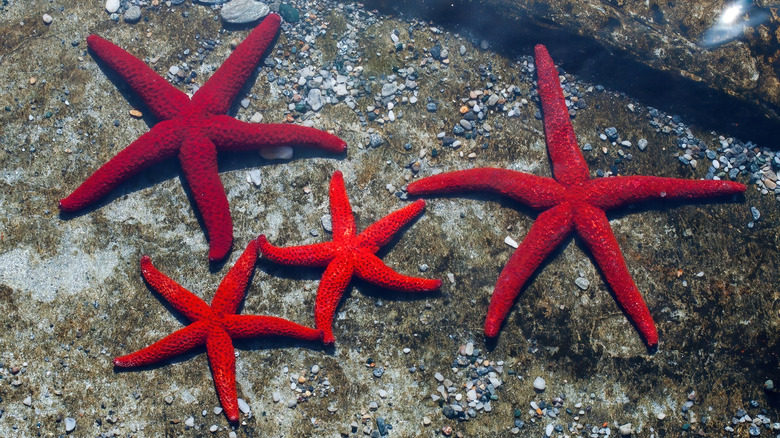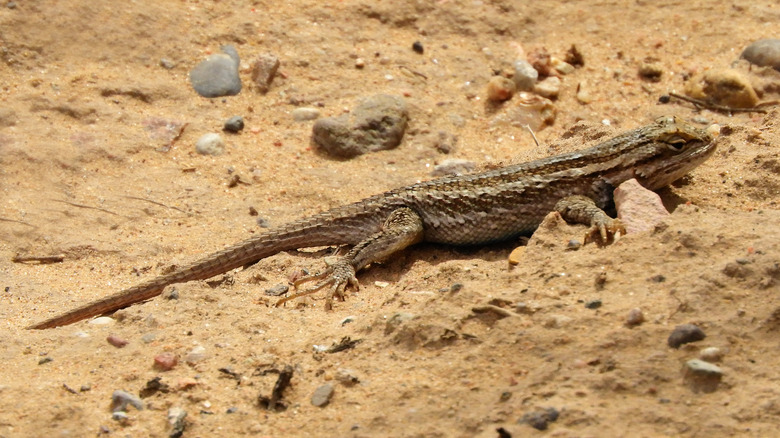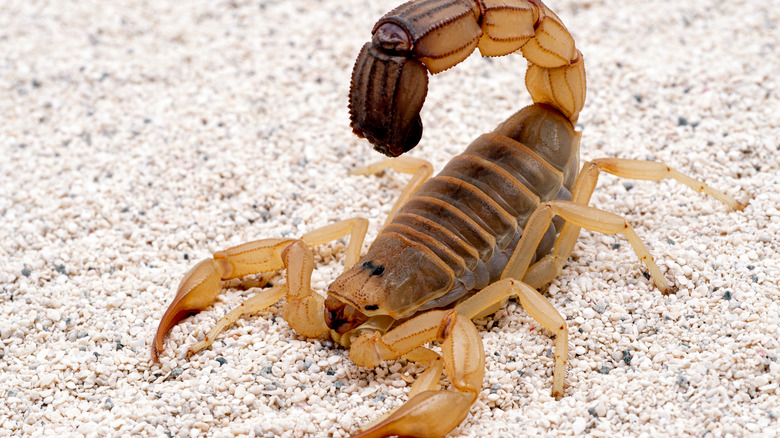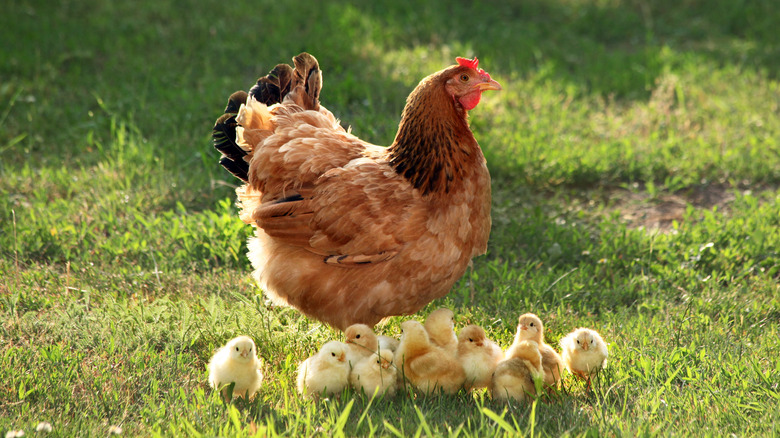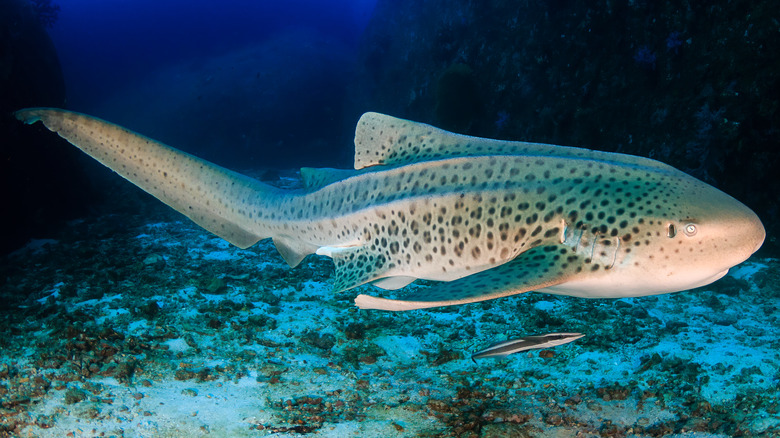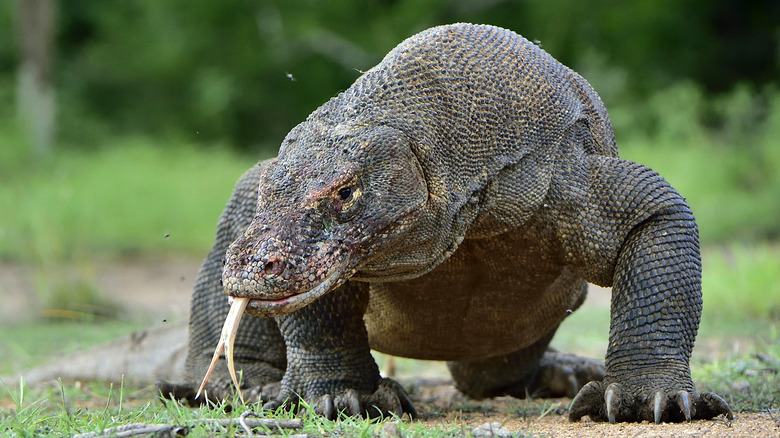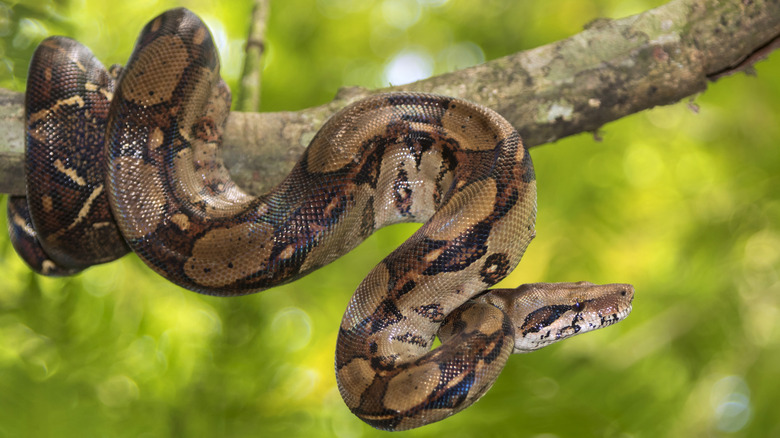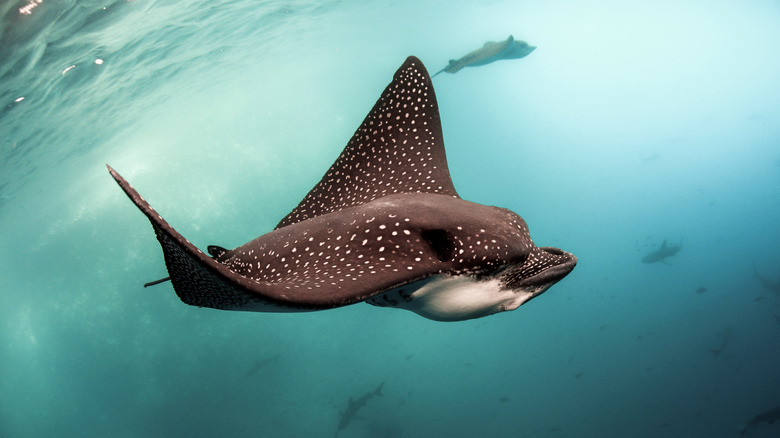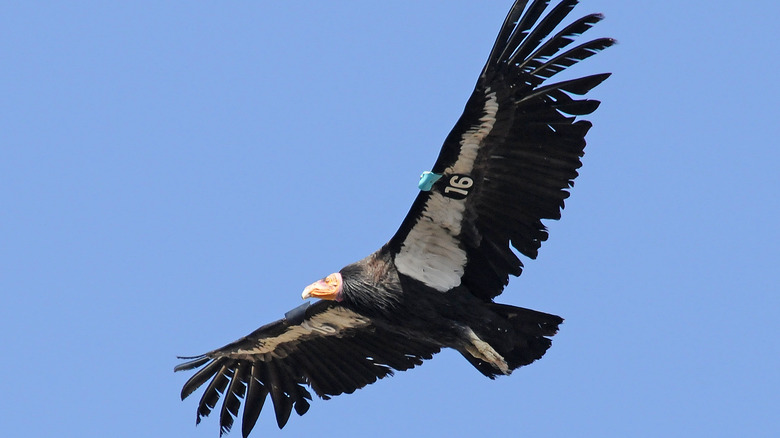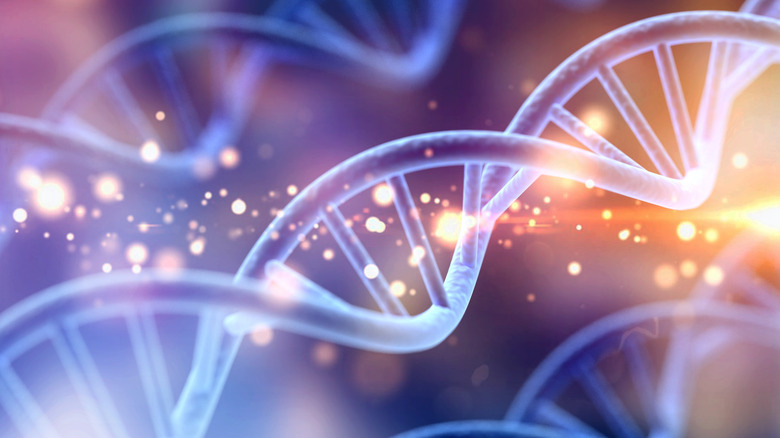Animals Who Can Reproduce Asexually
When it comes to animals producing offspring, most people probably have a pretty decent idea as to how that happens. An egg from the female parent gets fertilized by the sperm from the male parent, producing a zygote which continues to grow into a genetically unique offspring, one that's basically a combination of the two parents. That's sexual reproduction in a nutshell, and it's the thing that scientists have typically seen in over 99% of animal species (via Nature). It's everywhere.
Well, almost everywhere.
While sexual reproduction is a pretty popular process among a lot of animals, there is another option: asexual reproduction. Unlike in sexual reproduction, two parents aren't required, and a single organism can manage to give birth to a bunch of offspring. That said, it's not something that's seen all that often; it's mostly a thing for bacteria and plants, but a seemingly growing list of more complex animals can also make use of asexual reproduction. Here's just a few of them.
What's parthenogenesis?
Alright, so let's get into some of the science specifics that are relevant to a bunch of the animals on this list. Because while asexual reproduction is kind of an umbrella term that encompasses a handful of different processes, there's a particular term that crops up pretty often, especially with some of the particularly wild stories. That term? Parthenogenesis.
According to National Geographic, "parthenogenesis" comes from two Greek roots that translate to "virgin creation," and it's a really fitting term. While sexual reproduction depends on the combination of an egg and a sperm — the two main donors of genetic material — parthenogenesis allows for reproduction without the presence of sperm. And this can be done in one of two ways. One of those ways is, essentially, just cloning. A starting cell will divide and clone itself — the exact same process that happens regularly in your body — but that new cell will grow to become its own individual organism (albeit a clone of the parent). The more complicated process involves some leftover byproducts of creation of sex cells — eggs, in this case. These polar bodies can act like sperm, fertilizing an egg and creating viable offspring, despite the lack of a male partner.
The study of parthenogenesis is far from complete, with a fairly small group of animals (and an even smaller group of complex vertebrates) having been observed reproducing via parthenogenesis. As far as anyone can tell, it seems to be a last-ditch survival strategy for species in less-than-favorable living conditions, but that's all anyone can really guess.
Starfish
Starfish are some pretty funky little animals. After all, at first glance, you can't even really tell how their anatomy works (do they even have a head? If they do, where is it?), but they're mostly recognizable just because they literally look like stars.
Well, at least they usually do. According to the Marine Education Society of Australasia, starfish will usually have five arms, though that number is pretty flexible, with some species wielding up to 50 arms. They generally hang out near the sea floor, anchoring themselves into the mud in order to catch their meals — decomposed plant and animal life, coral, and plankton, among other things. They also don't have an actual brain, opting for a decentralized nervous system that responds to changes in the environment.
On the reproductive front, starfish are capable of both sexual and asexual reproduction, though their method of accomplishing the latter is different than a lot of other animals on this list. It's also, arguably, a lot simpler. Rather than deal with fertilization of eggs, starfish can reproduce via a process called "fragmentation." If a piece of the starfish gets chopped off from the main body, it doesn't die; instead, it grows a completely new body and becomes its own, independent starfish. Strangely enough, according to an article published in Heredity, this cloning process seemed to produce starfish that lived longer than their counterparts born via sexual reproduction.
Desert Grassland Whiptail Lizards
If you took any random population of a type of animal, you'd probably expect to see both male and females of that species, right? After all, that's just how sexual reproduction works, in a really general sense. But when you pull asexual reproduction and parthenogenesis into the mix, then, well, the rules start to change.
See, because of how parthenogenesis works, offspring are only able to inherit X chromosomes; according to National Geographic, that ends up meaning that parthenogenetic species will end up producing almost entirely female offspring. And that's exactly the case with the Desert Grassland Whiptail Lizard. The Toronto Zoo explains that this species of little lizards is made up entirely of females, living largely in the southwestern U.S. and northern Mexico. They also appear to engage in copulation with another female lizard, though the reason why is a little hazy. It might be a way that the lizards induce asexual reproduction, as far as anyone can guess.
The way in which these lizards started reproducing asexually is also a bit of a question. Per National Geographic, there's a theorized "hybridization event" that kickstarted the whole thing, in which one female mated with another male of a different species. That gave them a bit more genetic diversity — as does this weird process these lizards in particular use to double their chromosome count prior to reproduction — which allows their population to stay a bit healthier than most parthenogenetic species.
Scorpions
No doubt you're really excited to read about scorpions because they're just so cute and cuddly, right? Not at all scary or venomous in the slightest, you know? Okay, but, in all honesty, to each their own. Scorpions can be pretty cool, too.
After all, scorpions do get to be a part of this list, being one of a small group of species capable of asexual reproduction. And to get even more specific, it's scorpions of the particular tityus genus that have been fascinating scientists with their reproductive methods. A 2008 article published in the Journal of Venomous Animals and Toxins including Tropical Diseases went through data on a couple of these scorpions of interest, like the Tityus Serrulatus, which basically follows the trends of parthenogenesis as they're understood. This particular family of scorpions is entirely female (though there are speculations of a small population consisting of both male and female scorpions) and seems to have developed the ability to reproduce asexually as a result of their environment. They tend to reside in isolated parts of the savannah — places that might have been difficult for both males and females to reach in significant numbers. Parthenogenesis allowed them to survive there.
But there's also an even weirder type of scorpion: the Tityus Metuendus. In an especially weird case, one female scorpion underwent parthenogenesis on multiple occasions, giving birth to multiple broods, all of which were entirely male. It was the first case of all-male broods born through parthenogenesis among most types of arachnids.
Chickens and turkeys
In all honesty, chickens and turkeys are probably the most seemingly normal animals you'll see on this list, what with insects and reptiles (via National Geographic) being among the more likely culprits for parthenogenesis. But chickens and turkeys are capable of parthenogenesis, too; it's just ... a weird situation.
A study published in Nature back in the 1970s took a look at parthenogenetic chickens, but they did so under extremely well-controlled conditions. They took a ton of eggs from virgin hens which the researchers knew had been kept completely separate from male chickens. Those eggs were kept under careful watch for the month until they hatched, after which they were still under close watch — and even hand-fed — so that they wouldn't succumb to complications in their intestines (a common problem with these chicks). It was a tedious procedure, to say the least, with a decent number of dead chicks, but four of those parthenogenetic chickens did survive; one even mated with another female!
A later study published in Poultry Science talked a bit more about the reasoning behind how this all works, explaining that, while the unfertilized eggs are haploid (containing only one pair of chromosomes), the offspring have diploid cells (containing two pairs of chromosomes, like most other cells). The reason isn't fully understood — the theory is that the egg recombines with another cell fragment, essentially — but the process is incredibly rare and random in chickens and turkeys, and the resulting eggs require a longer incubation period.
Zebra Sharks
The Reef HQ Aquarium in Australia had some really, really strange days in the mid-2010s. The Aquarium had long been home to a female zebra shark named Leonie, who had been living with her male mate from 2006 until 2012, according to CNN. The pair had produced a number of litters over the years, per Live Science, then in 2012, Leonie — and one of her female offspring, named Lolly — were both moved into a separate area, away from any male sharks.
For a couple years, nothing strange happened, but then, in 2014, both Leonie and Lolly laid eggs. Not the weirdest thing — sharks can lay eggs regardless of whether they're fertilized or not — but some of these eggs seemed to actually have embryos. Researchers were curious, but they weren't able to successfully hatch any of those eggs. Fortunately, just a bit further into the future, Leonie and Lolly laid eggs again, and some of those eggs did hatch, and their offspring survived. Initially, researchers didn't suspect anything too strange; female sharks are able to store sperm, essentially giving them the ability to undergo normal sexual reproduction, even if they haven't seen a male in years. But DNA analysis revealed something weird: these offspring were genetically really similar to their mothers.
This was the first reported case of parthenogenesis in sharks, and it raised other questions. Namely, Leonie (and Lolly) had both reproduced sexually in the past but had apparently adapted in the absence of a mate. Maybe this happens more often in the wild than anyone ever realized?
Komodo Dragons
With how the genetics shake out in parthenogenesis, the options for offspring produced in this way are kind of limited. As explained by Scientific American, offspring born via parthenogenesis will end up with two of the same sex chromosomes. So when it comes to Komodo dragons, which have Z and W chromosomes (with WZ being female, ZZ being male, and WW being, well, not a viable combination), parthenogenesis should always produce male offspring.
And that's exactly what was seen on a couple different occasions at zoos in England in 2006. The earlier case involved a Komodo dragon which hadn't seen her male mate in well over two years, yet laid a bath of 22 eggs, four of which successfully hatched. Investigations into the question of whether or not the reptile had stored sperm came up empty, and it was decided that she had, in fact, reproduced asexually (before later producing another set of offspring via sexual reproduction). The latter case, reported on by Live Science, involved a Komodo dragon that had never contacted a male dragon at all, but one day laid 25 eggs (11 of which were fertile). Not all of those eggs made it to hatching, though; three of them collapsed, but DNA analysis of those eggs did confirm that parthenogenesis had occurred (not that there seemed to be much doubt in this particular case).
Boa Constrictors
As luck would have it, snakes like boa constrictors are just another species that have had researchers scratching their heads over parthenogenesis. See, according to an article published in Biology Letters (via Science Daily), snakes work a little differently than mammals on the genetic front. While mammals — in a very general sense — will see females with two X chromosomes and males with one X chromosome and one Y chromosome (via NCBI), snakes are kind of the opposite. A male will have two Z chromosomes, and a female will have a Z and W chromosome.
Bearing that in mind, researchers ended up in a really bizarre position: The female boa they were studying (which had already given birth via sexual reproduction) ended up giving birth to multiple broods asexually, despite the presence of male snakes. And on top of that, those broods had females with two W chromosomes — the type of thing that had only ever been seen in the lab before as a result of intentional manipulation. How this happened naturally is really anyone's guess.
That said, boa constrictors aren't the only snakes to undergo parthenogenesis. In 2021. AZCentral reported on a female rainbow boa — which had never had a male partner — suddenly giving birth, surprising the zookeepers who just found a new baby snake one day. And that wasn't even the first documented case of parthenogenesis for that particular species (it was actually about 12 years too late for that title).
Eagle Rays
Another entry in the category of "animals that surprised zookeepers by giving birth to offspring" is the eagle ray. Also like a couple of other animals mentioned here, this wasn't just one isolated incident.
The earlier recorded case of asexual reproduction with eagle rays came in 2018, when aquarists at Sea Life Sydney Aquarium started noticing one of their female rays, Freckle, displaying behaviors indicative of being pregnant ... despite having had no contact with a male eagle ray for over nine years. For obvious reasons, they dismissed the idea that she was pregnant, until suddenly they had a new baby eagle ray on their hands. Given the situation, they came to the conclusion that the birth had occurred via parthenogenesis.
Only a few years later in 2021, a very similar thing would happen, except in New Zealand, and with two eagle rays, rather than just one. According to The Guardian, two eagle rays at the SEA Life Kelly Tarlton's Aquarium suddenly gave birth, despite being separated from males for a solid two years. Scientists initially pointed to sperm storage — a process that can keep sperm viable for up to the requisite two years — but it's also not a process that eagle rays really partake in. (They can store sperm, but compared to other deep-sea dwellers, it's pretty uncommon for eagle rays.) Bearing that in mind, scientists suspect parthenogenesis to be the more likely candidate but want to wait until the offspring grow up before confirming it through DNA testing.
California Condors
So, condors just might be one of the more surprising animals to go through asexual reproduction. For one, it's a bird species — not an insect or reptile — and a really complex organism at that: not exactly the usual candidate for this type of reproduction.
But the story goes like this: according to The Guardian, in the 1980s, the San Diego Zoo started doing a bit of genetic testing on California condors, specifically because the species was hovering on the brink of extinction (blame hunters and human settlement for that one). They wanted to figure out the sex of the few condors remaining at the time, but that research continued on for over 30 more years, collecting more and more genetic data on the growing population of condors.
By 2021, scientists were doing full genetic analyses of these DNA samples, and they stumbled on something a little odd. Two male chicks seemed to have no genetic material from any father, and both died young — only living for 2 and 8 years, respectively, rather than the average 50. As told by Reuters, those two chicks were born from a couple of female condors, both of whom were kept in captivity with fertile male partners. By all rights, it seemed like they should've mated with their male partners, but they just ... didn't. Instead, they reproduced asexually, though the exact reason why isn't really understood.
The downsides of asexual reproduction
Asexual reproduction is really quite interesting, and it also seems surprisingly helpful, at least in the right conditions. After all, populations in isolated areas can keep their species going, even if there aren't both males and females present. For that matter, a single female could, hypothetically, sustain her entire species.
That said, there are some definite downsides. For one, if you were wondering whether or not humans could manage that, then you're out of luck. According to National Geographic, mammals go through an additional process during reproduction called genomic imprinting. This basically marks certain genes by which parent they came from, allowing some of those genes to be turned off depending on the parent they came from. Asexual reproduction would throw a massive wrench in that process, so parthenogenetic mammals don't seem too likely.
On top of that, sexual reproduction allows for a lot of mixing of different genes; each generation is markedly different from the one that came before it. Even in parthenogenesis, which does allow for some reshuffling of genes, offspring are very similar to their parent. In the short term, a population with low genetic diversity can prove really susceptible to things like disease or just changes in the environment. In the long term, you'd end up running into the usual medical problems that are associated with inbreeding (via Live Science). Sexual reproduction just tends toward higher genetic diversity in general, which provides a natural protection against these less-than-desirable situations.
